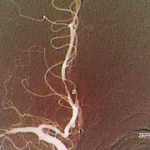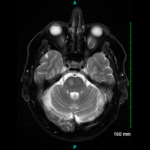
Andrei_R/shutterstock.com
WASHINGTON, D.C.—New insights into maintenance therapy for patients with vasculitides were covered by several speakers at the 2016 ACR/ARHP Annual Meeting abstract session titled, Vasculitis I: Novel Approaches to Therapy.
Expert Hubert de Boysson, MD, MSc, of the Internal Medicine Department at Caen University Hospital in France, led discussion on new therapies for patients with primary angiitis of the central nervous system (PACNS).
Researchers in France, he said, have found that maintenance therapy after induction treatment produced good results more often than no maintenance in patients with PACNS. Good outcome was defined as relapse-free survival and good functional status at their last follow-up.1
“Maintenance therapy should be prescribed once remission has been achieved,” Dr. de Boysson said.
The results of the researchers’ findings were not randomized, although there were no statistical differences seen between the maintenance and no-maintenance groups across a range of demographic and clinical factors.
A problem in PACNS is that 27% of patients with PACNS go on to relapse, and about 80% live with disabilities, so new approaches are needed, Dr. de Boysson said.
Researchers looked at 97 patients with PACNS—some retrospectively—treated since 2010 at several centers in France. Patients were a median age of 46 years old and were followed for a median of
55 months. Ninety-five patients were given glucocorticoids as induction therapy, which was combined with an immunosuppressant—mostly cyclophosphamide (CYC)—for 80 patients.
Maintenance therapy was given to 48 patients, 42 of whom had previously been treated with CYC. Maintenance was azathioprine for 38 patients, mycophenolate mofetil for four patients and methotrexate for six. The medication regimens were prescribed for a median of 24 months.
Good outcomes were seen in 32 of the 48 patients, or 67%, getting maintenance, compared to just 10 of 49 patients who did not receive maintenance, Dr. de Boysson said.
Being put on maintenance therapy was the only statistically significant predictor of a good outcome (P <0.0001) out of all the factors examined, including modified Rankin Scale (mRS) score for functionality, Dr. de Boysson said.
Patients on maintenance also needed less treatment with glucocorticoids, with lower doses that were statistically significant beginning at six months—and continuing at 12 and 18 months—after the patient’s induction therapy had begun, researchers found.
Dr. de Boysson said researchers are continuing to follow new patients in the French cohort and that international studies are underway to further study the maintenance therapy approach.
Tocilizumab in Takayasu’s Arteritis
Sharing insights on another study, researchers from Japan discussed the results of what they said was the first randomized, double-blind, controlled trial of a therapeutic agent for the treatment of Takayasu’s, a rare form of arteritis involving the aorta and its main branches and affecting women far more often than men.2 It can cause disability and can require surgery.
Researchers enrolled 36 patients with Takayasu’s who relapsed while on corticosteroid treatment and who were then given at least twice their corticosteroid dose at relapse in order to bring them into remission. Relapse was defined as meeting at least two of these criteria: objective systemic symptoms, such as fever or weight loss; subjective systemic symptoms, such as malaise or headache; elevated inflammation markers; vascular lesions including bruises or loss of pulse; or ischemic symptoms accompanied by organ lesions. Imaging was not required when assessing patients for these relapse criteria.
After reaching remission, patients were randomized to receive either 162 mg per week of the anti–interleukin 6 agent, tocilizumab (TCZ), subcutaneously or placebo. The corticosteroids were tapered.
After 48 weeks, there was a trend (P=0.0596) toward relapse suppression for the TCZ group, but the primary endpoint of time to first relapse was not meant because it wasn’t statistically significant, said Yoshikazu Nakaoka, MD, PhD, of the National Cerebral and Cardiovascular Center Research Institute in Osaka, Japan.
The amount of time that passed before patients showed at least two of the five criteria for relapse—the “time to signs of relapse”—were all individually longer in the TCZ group, Dr. Nakaoka said.
There was a similar number of adverse events in each group.
“Although the primary endpoint was not met, a trend favored tocilizumab over placebo for time to relapse of Takayasu’s without new safety concerns,” Dr. Nakaoka said.
‘We need to better identify the patients that really need tocilizumab for GCA & optimal duration of this therapy in the course of disease.’ —Dr. Samson
Tocilizumab in GCA
On the topic of TCZ therapies, session speakers discussed an open-label study of 20 French patients newly diagnosed with giant cell arteritis (GCA) who were given four intravenous infusions of TCZ (at 8 mg/kg each) as an add-on therapy to glucocorticoids in their first three months of treatment for the disease.3 Researchers found that 75% of the patients met the primary endpoint of no relapse at 26 weeks while taking no more than 0.1 mg/kg per day of prednisone.
Researchers also found that relapse can occur after TCZ is stopped, especially in patients with aortitis, said Maxime Samson, MD, PhD, assistant professor of immunology at University Hospital in Dijon, France. He acknowledged that having no control group was a limitation. But the results, the researchers said, were nonetheless encouraging for the potential use of TCZ in this setting.
Adalimumab was studied as a steroid-sparing agent in GCA in the recent HECTHOR study, with the same endpoint and similar patient population, but with a control arm on prednisone and placebo.4 In that study, the prednisone-only arm reached the primary endpoint only 50% of the time, an indication that TCZ as an add-on might be superior to staying on prednisone only, Dr. Samson said.
Researchers said they saw no new safety signals for TCZ in the study.
“This research argues for systematic screening for aortitis at diagnosis,” Dr. Samson said. “And furthermore, we think that (in) further studies we need to better identify the patients that really need tocilizumab for GCA and optimal duration of this therapy in the course of disease.”
Thomas R. Collins is a freelance writer living in South Florida.
References
- De Boysson H, Arquizan C, Boulouis G, et al. Maintenance therapy improves long-term outcomes in patients with primary angiitis of the central nervous system [abstract 975]. Arthritis Rheumatol. 2016;68 (suppl 10).
- Nakaoka Y, Isobe M, Takei S, et al. Efficacy and safety of tocilizumab in patients with refractory Takayasu arteritis: Results from a randomized, double-blind, placebo-controlled Phase 3 trial in Japan [abstract 976]. Arthritis Rheumatol. 2016;68 (suppl 10).
- Samson M, Devilliers H, Ly KH, et al. Tocilizumab as an add-on therapy to glucocorticoids during the first 3 months of treatment for giant cell arteritis: Results of a French multicenter prospective open-label study [abstract 977]. Arthritis Rheumatol. 2016;68(suppl 10).
- Seror R, Baron G, Hachulla E, et al. Adalimumab for steroid sparing in patients with giant-cell arteritis: results of a multicentre randomised controlled trial. Ann Rheum Dis. 2014 Dec;73(12):2074–2081.


